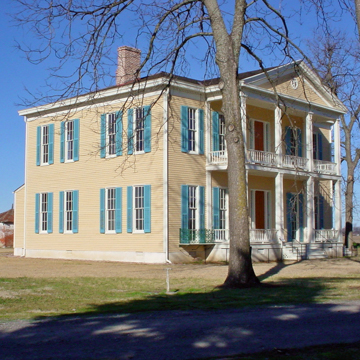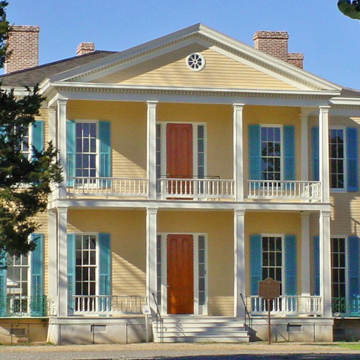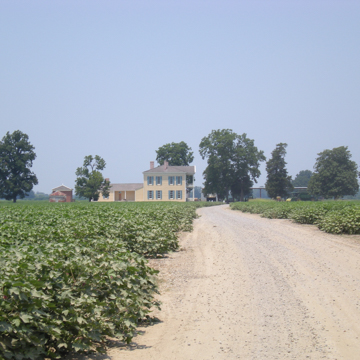The juxtaposition of the gleaming-white Greenville Bridge (CH4) looming in the background of Arkansas’s last antebellum plantation house on the Mississippi River is breathtaking. Before the Civil War Lakeport was one of the largest plantations in Arkansas in acreage and in number of slaves. The cotton plantation was established by Joel Johnson, who came to Chicot County from Kentucky in 1831 and began acquiring land. At the time of his death in 1846, he owned 3,700 acres and 95 slaves. Although he divided his estate among his six children, his eldest son, Lycurgus Johnson, acquired the larger portion, to which he added acreage he already owned, and by 1860, Lycurgus Johnson owned 4,400 acres and 155 slaves. In 1859, Johnson’s enslaved laborers began to construct this house for him and his wife, Lydia. The house retains its original architectural features and many of its decorative finishes. Though less architecturally sophisticated or elaborate than contemporary plantation houses in Louisiana or southern Mississippi, the size of this two-story house encompassing eight thousand square feet, with fourteen-foot-high ceilings and twelve-foot-high doors, is striking. It is built mostly of cypress, and the exterior is painted a buff yellow with blue-green shutters, its original colors. The house faces the river and stands on a slight elevation at four feet above grade to prevent flooding. A two-story pedimented portico on four tapered, boxed piers covers the central three bays of the five-bay house, and the entrance opens to a central hall, twenty-six feet in length and almost sixteen feet wide. The floor plan, common in Kentucky, has an ell with the kitchen and commissary attached at the rear and the staircase set back in a secondary hall. The interior has been restored with its rosewood-grained doors, faux-marble painted fireplace mantels, and original color schemes.
The Civil War saw battles and skirmishes in the area and goods and livestock raided. Nevertheless, Johnson still owned the land, and through sharecropping and wage work, his fortunes recovered. His former slaves, now freed, constituted much of his work force. But the early twentieth century brought changes, from fluctuating cotton prices to boll weevil infestations and drought, and these were followed by the Great Mississippi Flood of 1927, which inundated farms and towns in the Delta. Johnson’s son Victor, who then ran the plantation, relocated to Memphis, and in 1927 he sold the plantation to Sam Epstein, a Russian immigrant. Neither Epstein nor his descendants lived here, and his grandson, Sam Angel, donated the house to Arkansas State University in 2001 but continues to cultivate the land. Lakeport Plantation, one of the university’s Heritage Sites projects, was restored and opened in 2007 as a museum and education center, interpreting the peoples and cultures that shaped plantation life in the Mississippi River Delta. With cotton under cultivation here since the 1830s, Lakeport provides a context for studying changes in agricultural and the African American experience—from frontier and plantation slavery to sharecropper and tenant farmer systems, agricultural mechanization, the mass exodus of African Americans to factories in the North, and modern-day farming practices. It is also the southern anchor for the Arkansas segment of the Great River Road, a National Scenic Byway that extends through ten states along both sides of the Mississippi River.














